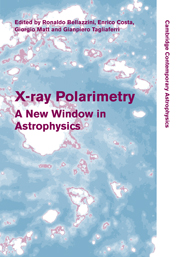Book contents
- Frontmatter
- Contents
- List of contributors
- Preface
- 1 X-ray polarimetry: historical remarks and other considerations
- Part I Polarimetry techniques
- Part II Polarized emission in X-ray sources
- Part III Future missions
- 37 Gravity and Extreme Magnetism SMEX (GEMS)
- 38 Programs of X-ray polarimetry in Italy
- 39 A polarimeter for IXO
- 40 Polarimetry with ASTRO-H soft gamma-ray detector
- 41 The Energetic X-ray Imaging Survey Telescope and its polarization sensitivity
- 42 PoGOLite: a balloon-borne soft gamma-ray polarimeter
- 43 Studies of neutron background rejection in the PoGOLite polarimeter
- 44 Observing polarized X-rays with PoGOLite
- 45 Pre-flight qualification tests of the PoGOLite detector system
- 46 The Gamma-RAy Polarimeter Experiment (GRAPE) balloon payload
- 47 POLAR: an instrument dedicated to GRB polarization measurement
- 48 Polarization detection capability of GRIPS
- 49 X-ray and γ-ray polarimetry small-satellite mission PolariS
- 50 GAP aboard the solar-powered sail mission
- 51 Hard X-ray polarimeter for small-satellite missions
- 52 Performance of hard X-ray polarimeter: PHENEX
- 53 GRB polarimetry with POET
- Author index
- Subject index
40 - Polarimetry with ASTRO-H soft gamma-ray detector
from Part III - Future missions
Published online by Cambridge University Press: 06 July 2010
- Frontmatter
- Contents
- List of contributors
- Preface
- 1 X-ray polarimetry: historical remarks and other considerations
- Part I Polarimetry techniques
- Part II Polarized emission in X-ray sources
- Part III Future missions
- 37 Gravity and Extreme Magnetism SMEX (GEMS)
- 38 Programs of X-ray polarimetry in Italy
- 39 A polarimeter for IXO
- 40 Polarimetry with ASTRO-H soft gamma-ray detector
- 41 The Energetic X-ray Imaging Survey Telescope and its polarization sensitivity
- 42 PoGOLite: a balloon-borne soft gamma-ray polarimeter
- 43 Studies of neutron background rejection in the PoGOLite polarimeter
- 44 Observing polarized X-rays with PoGOLite
- 45 Pre-flight qualification tests of the PoGOLite detector system
- 46 The Gamma-RAy Polarimeter Experiment (GRAPE) balloon payload
- 47 POLAR: an instrument dedicated to GRB polarization measurement
- 48 Polarization detection capability of GRIPS
- 49 X-ray and γ-ray polarimetry small-satellite mission PolariS
- 50 GAP aboard the solar-powered sail mission
- 51 Hard X-ray polarimeter for small-satellite missions
- 52 Performance of hard X-ray polarimeter: PHENEX
- 53 GRB polarimetry with POET
- Author index
- Subject index
Summary
ASTRO-H is a next-generation JAXA X-ray satellite to be launched in 2014. The Soft Gamma-ray Detector (SGD) onboard ASTRO-H is a semi-conductor Compton camera with a narrow field-of-view (FOV) to achieve very low background. Although the SGD is primarily a spectrometer in the 40–600 keV energy band, it is also sensitive to polarization in the 50–200 keV energy band. This paper describes instrument design, expected performance, and experimental validation of polarimetric performance of the SGD.
Introduction
ASTRO-H, the new Japanese X-ray Astronomy Satellite following Suzaku, is a combination of
high energy-resolution soft X-ray spectroscopy (0.3–10 keV) provided by thin-foil X-ray optics (SXT, Soft X-ray Telescope) and a microcalorimeter array (SXS, Soft X-ray Spectrometer);
soft X-ray imaging spectroscopy (0.5–12 keV) provided by SXT and a CCD (SXI, Soft X-ray Imager);
hard X-ray imaging spectroscopy (3–80 keV) provided by multi-layer coating, focusing hard X-ray mirrors (HXT, Hard X-ray Telescope) and silicon (Si) and cadmium telluride (CdTe) cross-strip detectors (HXI, Hard X-ray Imager);
soft gamma-ray spectroscopy (40–600 keV) provided by semiconductor Compton camera with narrow FOV (SGD, Soft Gamma-ray Detector).
The SXT-SXS and SGD systems will be developed by an international collaboration led by Japanese and US institutions.
The SXS will use a 6×6 format microcalorimeter array. The energy resolution is expected to be better than 7 eV. The FOV and the effective area will be, respectively, about 3 arc minutes and about 210 cm2 combined with the ∼6 m focal-length SXT.
- Type
- Chapter
- Information
- X-ray PolarimetryA New Window in Astrophysics, pp. 275 - 283Publisher: Cambridge University PressPrint publication year: 2010
- 4
- Cited by

